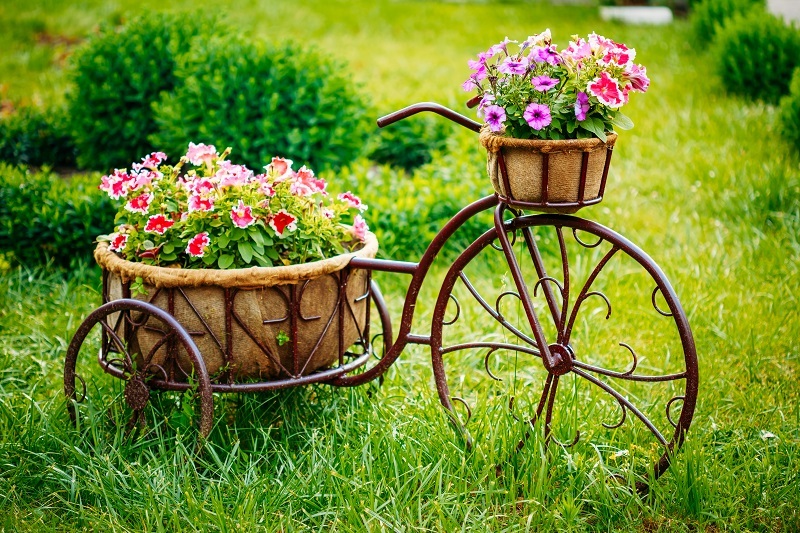Transform Fading Blooms with Simple Preservation Techniques
Posted on 18/08/2025
Transform Fading Blooms with Simple Preservation Techniques
Flowers hold unmatched beauty and charm, brightening up any space with their vibrant colors and delicate form. But as all gardeners and flower lovers know, fresh flowers don't last forever; their enchantment fades as blooms wilt and petals drop. What if you could stop time and preserve these living treasures for much longer? This comprehensive guide reveals exactly how to transform fading blooms with simple preservation techniques, extending their life and helping you enjoy memories and aesthetics for months or even years.
Why Preserve Your Fading Blooms?
Flowers often hold emotional significance--marking celebrations, offering condolences, or decorating your favorite space. Watching a cherished bouquet wither can be disheartening. Fortunately, there are accessible flower preservation techniques that enable anybody to maintain their beauty. Preserved blooms become long-lasting mementos that capture the essence of special occasions and natural beauty.
- Sentimental Value: Keep a wedding bouquet, graduation corsage, or other cherished arrangements alive.
- Eco-friendly Decor: Reuse preserved flowers for sustainable interior decor, reducing waste.
- Creative Projects: Utilize preserved flowers for crafts, scrapbooking, artwork, and more.
- Cost-effective: Extend the value of every bouquet by making it last far beyond its natural span.

Understanding Flower Preservation
The process of flower preservation halts or dramatically slows down the natural decay, enabling you to prolong the beauty of your fading blooms. Each technique offers varied results depending on the flower's structure, moisture content, and your personal preference for appearance. Some methods retain color and form exceptionally well, while others infuse vintage charm by creating unique textures or muted hues.
Main Techniques to Transform Fading Blooms
Each simple preservation method has its unique benefits and best-use scenarios. Explore the tried-and-true ways to give your favorite flowers a second life.
1. Air Drying - Traditional & Effortless
Air drying is the oldest and most accessible way to preserve wilting blooms at home. This technique works particularly well with robust flowers such as roses, lavender, statice, and baby's breath.
How to Air Dry Fading Flowers:
- Choose wisely: Select flowers just as they begin to fade, but before petals fall. Remove excess foliage to prevent mold.
- Bundle & tie: Gather small bunches and tie the stems securely with twine or a rubber band.
- Hang upside down: Suspend bundles upside down in a dark, dry, and well-ventilated area. This helps maintain their shape and color.
- Wait patiently: Allow flowers to dry for 2-4 weeks. They're ready when stems are brittle and petals feel crisp.
Tip: To maintain color, avoid sunlight, which can bleach petals during the drying process.
2. Pressing Flowers - Flattened Beauty
Flower pressing is a timeless way to preserve delicate blooms and create beautiful, lasting displays for art, stationery, and framing.
How to Press Fading Flowers:
- Prep the blossom: Select flowers with minimal moisture. Thicker blooms (like roses) can be split in half for easier pressing.
- Arrange: Place blooms and foliage between two pieces of absorbent paper (such as blotter or parchment paper).
- Weigh down: Enclose the paper within the pages of a heavy book or a designated flower press. Weigh with additional books for firm pressure.
- Wait it out: Let the flowers press undisturbed for 2-4 weeks.
- Display: Carefully remove and use for framed art, journals, or greeting cards.
Pressed flowers retain vibrant color and intricate detail, making them an exquisite choice for creative projects.
3. Silica Gel Preservation - For Vivid Color
For those aiming to preserve flowers in three dimensions while maintaining bright color, silica gel preservation is a top choice. The gel absorbs moisture rapidly and is reusable.
Instructions for Silica Gel Preservation:
- Pick the right blooms: Use fresh or slightly fading flowers that aren't too fragile.
- Pour a base: Add a one-inch layer of silica gel crystals to an airtight container.
- Nestle the blooms: Place flowers face up on the gel and gently sprinkle more silica over the petals until fully covered.
- Seal and wait: Close the container and let sit for 1 week (delicate flowers can take 3-5 days).
- Reveal the beauty: Carefully remove blooms and dust away any residual crystals with a soft brush.
Preserved flowers using this method maintain vivid hues and a natural shape, perfect for shadow boxes and long-term arrangements.
4. Glycerin Soaking - Soft and Supple Results
Want to maintain the flexibility and softness of your fading blooms? Glycerin soaking replaces plant water with glycerin, keeping stems and petals pliable and long-lasting.
How to Preserve with Glycerin:
- Mix solution: Blend one part glycerin with two parts warm water.
- Cut stems: Trim fresh or just-fading flower stems at an angle.
- Soak: Place stems in the glycerin solution for 2-3 weeks.
- Check progress: Flowers are ready when leaves and petals have a leathery feel and deep, rich color.
*Tip: This technique works best with foliage like eucalyptus, magnolia, and hydrangea. While some flowers may lose original vibrance, the result is a unique, timeless appearance.*
5. Microwave Flower Drying - Speedy Preservation
Short on time? The microwave method offers a rapid way to preserve your wilting blooms with minimal fuss.
Quick Steps to Microwave Dry Flowers:
- Sandwich flowers: Place flowers between two sheets of parchment paper inside a microwave-safe dish.
- Weigh down: Place a flat, microwave-safe plate on top.
- Heat: Microwave in 30-second increments, checking frequently, until flowers are dry (1-3 minutes total for thin blooms).
- Finish: Remove and let cool. If needed, press the blooms further in a book for several hours.
This creative preservation technique is best suited to small, flat flowers for quick, beautiful results, making it a favorite among crafters and impatient gardeners.
6. Resin Casting - Modern, Artistic Preservation
If you're searching for a stunning way to transform fading blooms into decorative keepsakes, consider encasing them in resin. This advanced technique results in clear, glass-like blocks that display your flowers' beauty indefinitely.
How to Preserve Blooms in Resin:
- Dry flowers: Use silica gel or pressing to thoroughly dry your blooms before starting.
- Prepare mold: Choose silicone molds in desired shapes (coasters, orbs, jewelry).
- Mix resin: Combine resin and hardener per manufacturer's instructions.
- Arrange flowers: Pour a small layer of resin, arrange flowers, then add more resin to cover.
- Set hard: Let cure in a dust-free area for 24-48 hours.
The result? Artistic, personalized keepsakes that capture the ephemeral beauty of any fading bloom forever.
Creative Ways to Reuse Preserved Blooms
Once you transform your fading flowers with these preservation methods, the possibilities for reusing them are nearly endless! Here are some inspiring ideas:
- Frame them as artwork for your home or as a thoughtful gift.
- Incorporate into greeting cards, wedding invitations, or scrapbooks.
- Arrange preserved flowers in shadow boxes or glass domes for eye-catching centerpieces.
- Craft flower jewelry such as pendants, earrings, or brooches using resin techniques.
- Create bookmarks, candles, or soaps adorned with dried petals and leaves.
- Add to wreaths or garlands for long-lasting seasonal decor.
Tips for Successful Flower Preservation
Transforming your fading blooms into long-lived treasures is rewarding, but success depends on a few key principles:
- Act promptly: Start the preservation process before petals drop and decay sets in.
- Select the right technique: Match the method to flower type and your intended use.
- Handle gently: Minimize bruising or crushing petals and stems.
- Avoid sunlight: Keep flowers from direct light during drying to reduce color loss.
- Monitor for mold: Especially in humid climates, be vigilant for any signs of mold during the process.
- Experiment: Don't be afraid to try different methods or combine them for creative effects!
Common Questions on Preserving Fading Blooms
What flowers preserve best?
Sturdy, low-moisture flowers like roses, lavender, baby's breath, and statice dry exceptionally well. Daisies, pansies, and hydrangeas are also popular candidates. Some tropicals and succulents may require specialized techniques for best results.
How long do preserved flowers last?
With proper preservation methods and care, dried or treated blooms can last from several months to multiple years. Keep them away from direct sunlight, moisture, and humidity for optimum lifespan.
Can I preserve a bouquet with different flowers?
Absolutely! Just be mindful of each flower's needs and drying time. For best results, separate each type during preservation and recombine in a new arrangement once all are ready.
How to clean preserved flowers?
Use a soft, dry brush or gently blow off dust with canned air. Never use water, as dried blooms are fragile and can be damaged by moisture.

Conclusion: Give New Life to Fading Blooms
Nature's splendor doesn't have to be fleeting! With these simple preservation techniques for fading flowers, you can celebrate cherished memories, creativity, and beauty all year round. Whether you're looking to commemorate a special event, decorate sustainably, or explore a new craft, preserved blooms offer endless joy and possibilities. Don't let your wilting bouquet be a sorrowful farewell--let it become a lasting token of life's beautiful moments.
Start transforming your fading blooms today--your home, memory books, and creative projects will thank you!
Further Resources
- Royal Horticultural Society: Preserving Flowers
- Better Homes & Gardens: How to Preserve Flowers
- Old Farmer's Almanac: Drying Flowers
Latest Posts
Transform Fading Blooms with Simple Preservation Techniques
Surprising truths about red roses and Valentine's Day
Create long-lasting holiday cheer with poinsettias
Transform Your Office: 10 Best Low-Care Plants for Indoor Spaces
